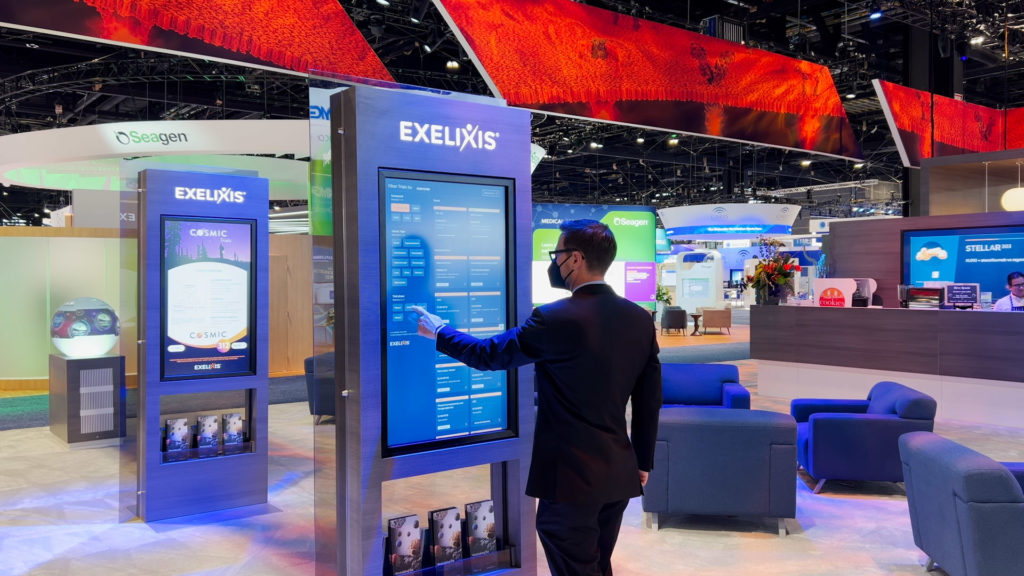
Interactive Medical and Scientific Conference Activities
Make your scientific messaging easier to understand and impossible to ignore with interactive medical and scientific conference activities. We design custom experiences around your scientific messaging to give conference attendees extra value for visiting your booth. We’ve given rheumatologists arthritis and dermatologists psoriasis, put healthcare providers face-to-face with a virtual patient, shown neurologists activity in their brains, and let oncologists battle cancer cells head to head! Check out our featured projects: educational games; disease state simulators; experience walls; holograms; photo booths; virtual reality (VR); augmented reality (AR); and mixed reality (MR).


Interactive MOA for Booth and Browser
3D Interactive Experience for Booth and Browser
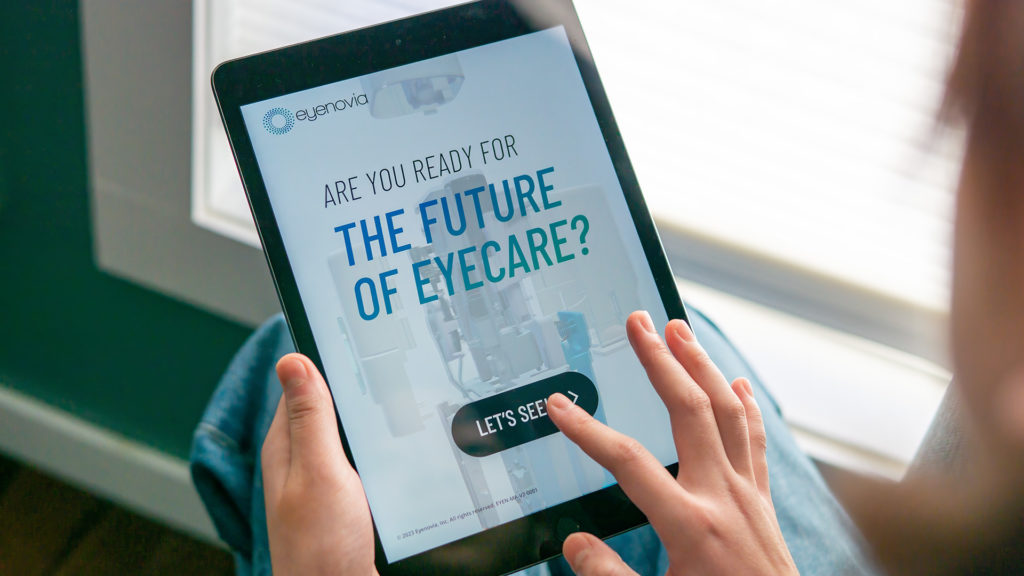
iPad App: Medical Device Simulator
Eyenovia
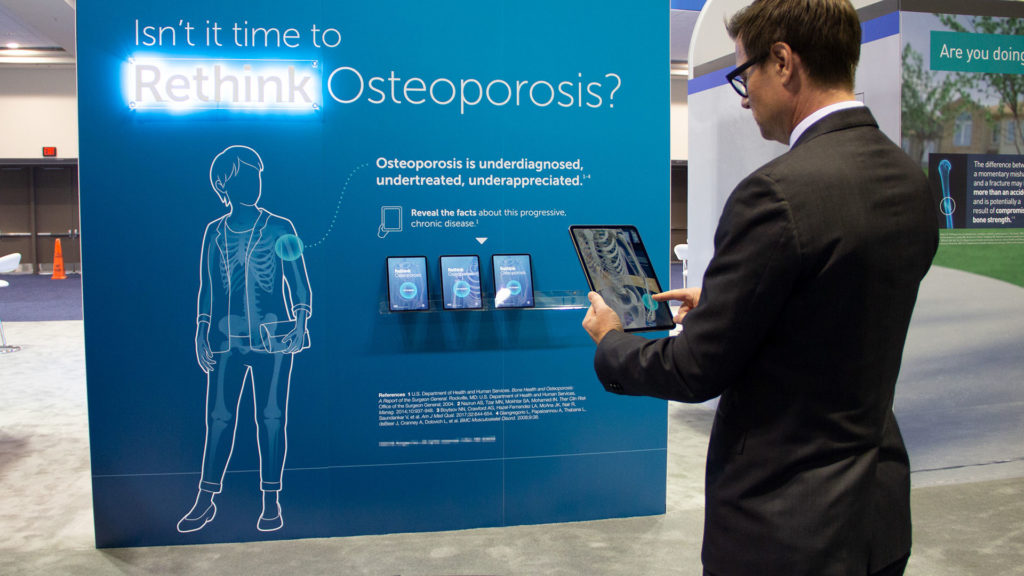
Medical AR: Interactive Osteoporosis Education
Biopharmaceutical Client
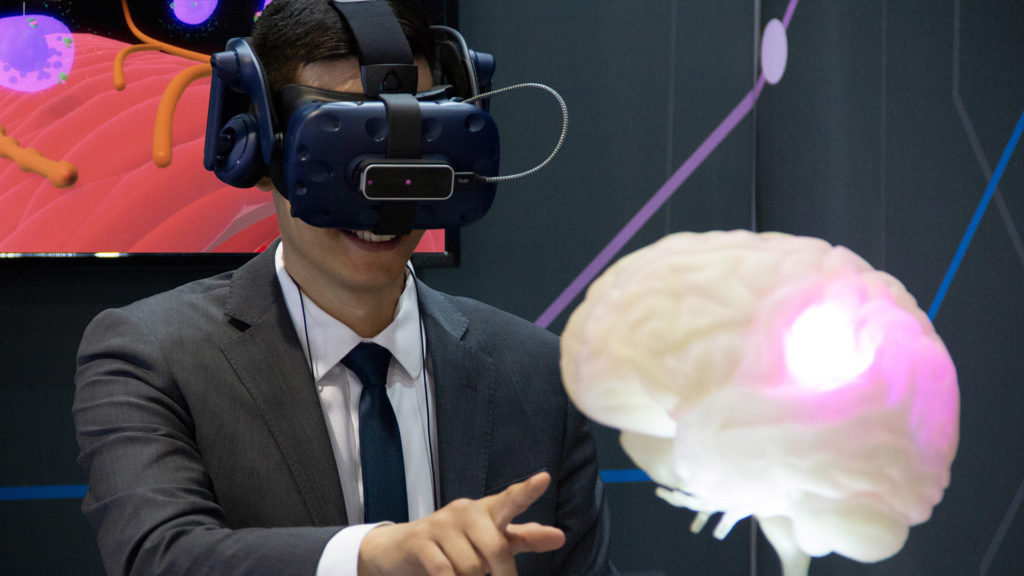
Interactive Migraine VR Experience
Biopharmaceutical Client
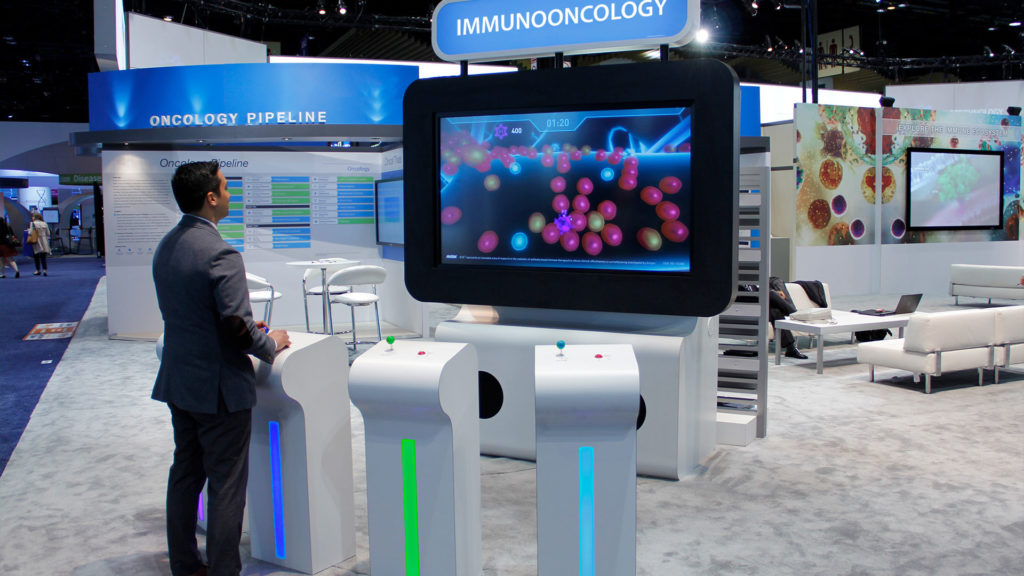
Medical Game: Oncology Arcade Experience
Biopharmaceutical Client

Biosimilar Development Simulator
Biopharmaceutical Client
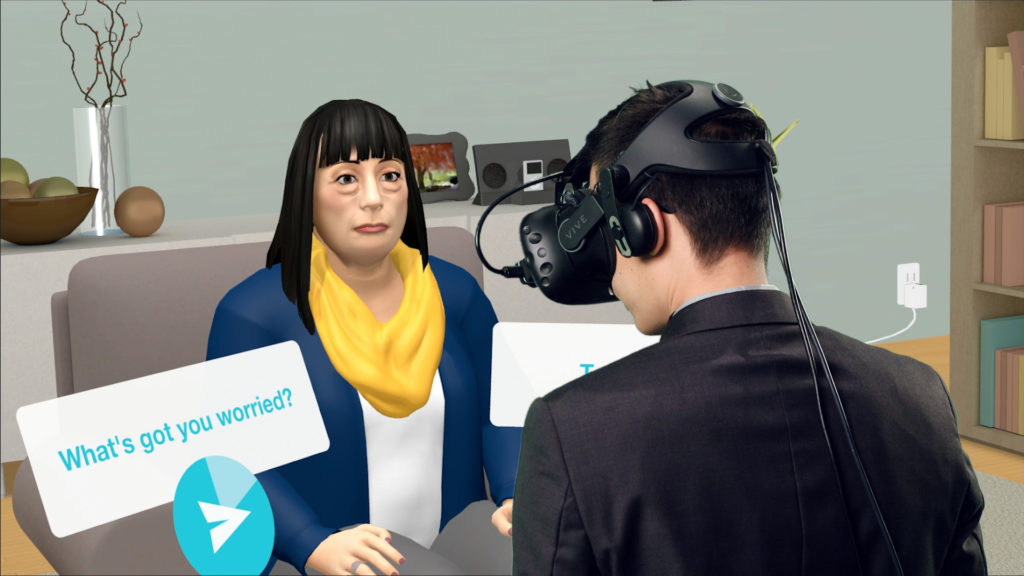
Medical Mixed Reality (MR): Cardiorenal Disease
Pharmaceutical Client
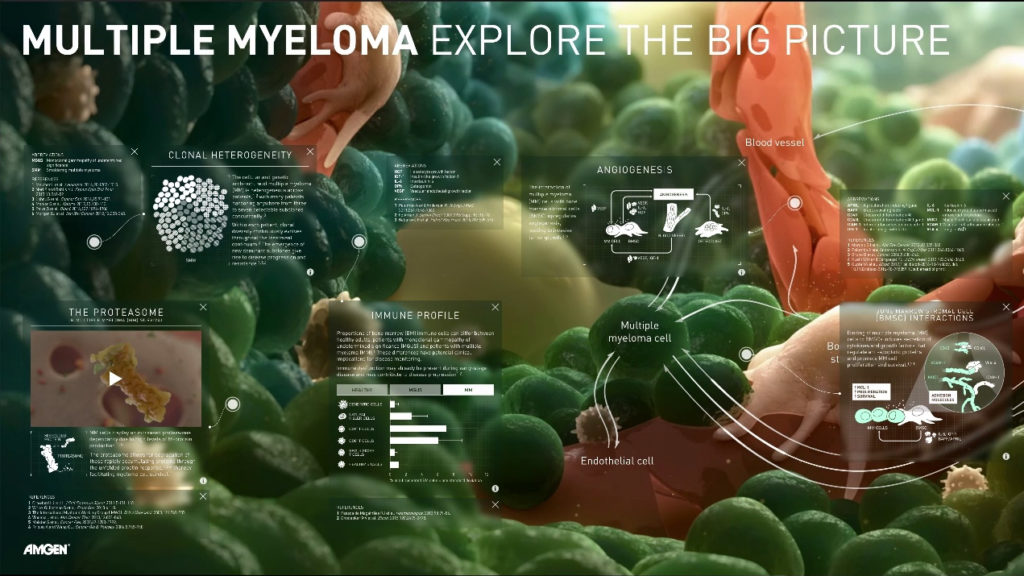
Multiple Myeloma Conference Exhibit
Biopharmaceutical Client
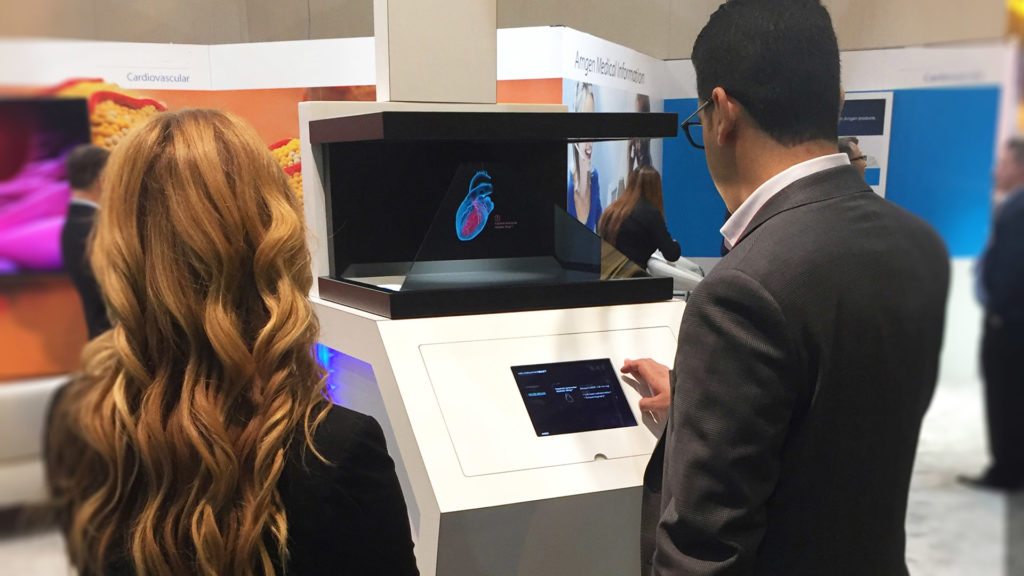
CVD Explorer interactive Hologram
Biopharmaceutical Client
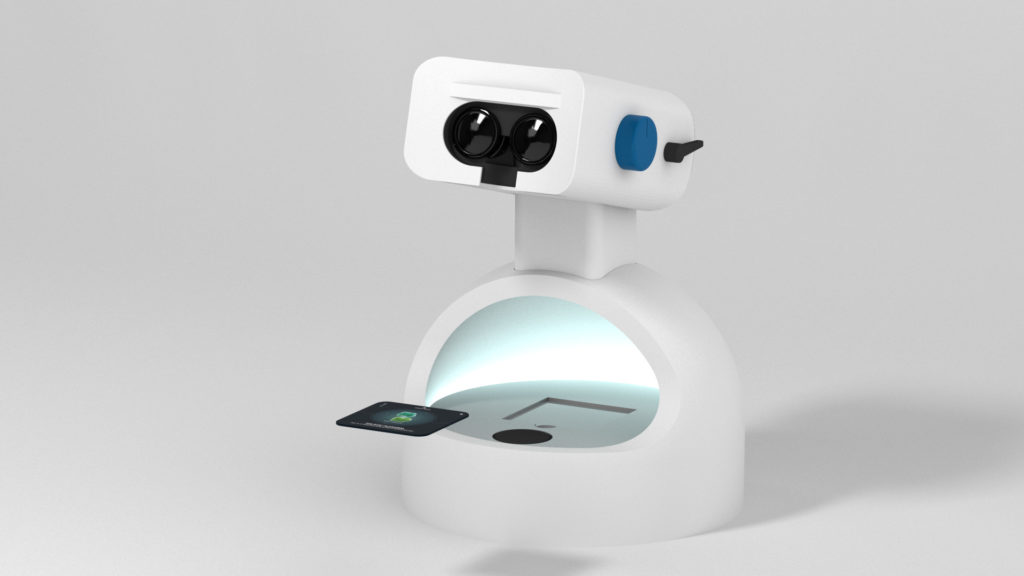
Medical VR: Cancer Immunotherapy Simulator
Biopharmaceutical Client

Medical AR: Psoriatic Arthritis Simulator
Biopharmaceutical Client
interactive-medical-scientific-conference-activities
https://axs3d.com/wp-admin/admin-ajax.php
2

It’s been an absolute pleasure working with AXS. They overhauled our scientific materials, providing a consistent look across all our tangible and digital assets to convey our scientific pipeline in a graphically appealing way.
Heather Douangpanya
Director, Global Scientific Communications, Seagen Inc.

Everything from the animation and the stills visually show the story of FaraPulse and the market leading product we set out to achieve. The final deliverables met and even exceeded the original vision. KUDOS and THANKS to you and the team on an AMAZING end product.
Dan Chase
Principal Product Manager, Boston Scientific

We chose AXS Studio because of their unique ability to curate a better, more visually impactful story resonating with both a scientific and non-scientific target audience.
Glen Tinevez
Vice President, Marketing North America Commercial Operations,
Ortho Clinical Diagnostics
Ortho Clinical Diagnostics

The AXS team was a pleasure to work with and I greatly appreciated their creative and scientific expertise. The videos received outstanding feedback and are one of the most popular assets for our disease state education campaign.
Rachel Raynes
Global Medical Communications, Senior Manager | Heart Failure GCCL, AMGEN

What a privilege and blessing it has been working with the AXS team these last few months. The incredible quality and attention to detail in your work, the care you put into navigating relationships, and the commitment you have to pulling off the impossible — it’s been a sight to behold. We are so grateful and appreciative of all your efforts. Thank you!
Susan Bartlett
Principal, Workomics

You guys are doing great work! The animation with the electric field displayed has been an 'AH-HA' moment for all of our Doctors, strategic collaborators and many of our employees!
Allan Zingeler
President & CEO, Farapulse

My previous vendor struggled to conceptually understand the purpose of the project. AXS understood and delivered an amazing product—better than what I initially imagined. We have experienced more engagement with key customers and investors, and the interactive will be a tool we can use across multiple platforms.
Julie Whitcomb
Head of Medical Affairs, Eyenovia

Wow! Just wow! 🤯 mind blown! This is amazing!! My heartfelt gratitude to your team. Their dedication to our project is only outweighed by their creative talents.
John West
Chief Development Officer, SciMar Ltd.

AXS was a true partner in creating highly compelling MOA videos for an important pharma client. They collaborated with us through numerous challenges on a tight schedule and hit our deadline with a product our client loved!
Senior Account Executive, Goodfuse

Thank you for being so great to work with and for creating such an amazing animation. Everyone loves it. Our Director of Sales called it “a game changer”. Our CEO presented the animation in recent talks and shared it with retina specialists. It is a hit! AXS has been a valuable partner and we look forward to working with you again in the future.
Allison Dabney
Director, Marketing, LumiThera

I can always rely on AXS to bring me unique, creative ideas for interactive media that boost traffic and HCP engagement at our congress booths.
Peter Baumeister
Senior Manager, Global Scientific Communications,
Amgen
Amgen

It’s been wonderful working with AXS Studio. The experience has been fantastic, fun, and rewarding. We have had glowing feedback on the video and are finalizing plans to integrate into discussions with all prospective research candidates. Our patient character is crushing it in the Alzheimer’s LP world.
Danielle Goldfarb
MD, Clinical Assistant Professor of Neurology and Psychiatry, Banner Sun Health Research Institute

These are absolutely fantastic visualizations. They convey the real science. I still am incredibly proud of what we did together on this video and I use it in my lectures to Harvard students and externally.
Donald E. Ingber
MD, PhD, Director, Wyss Institute for Biologically Inspired Engineering, Harvard University

The team at AXS are true pros. They asked all of the right questions from the start, from technical/scientific details to overall look and feel, and completed this amazing cover rather quickly as a result.
Kelly Krause
Creative Director, Nature

It is an absolute pleasure to work with the AXS team. Their work is consistently well-researched, beautifully crafted, and press-ready.
Jen Christiansen
Art Director of Information Graphics, Scientific American Magazine

Collaborating with the AXS team on high-impact science visualization projects is always a pleasure. I can rest assured that the final product will be clear, elegant, and beautiful while meeting our target audience’s needs.
Fabian de Kok-Mercado
Creative Director, Howard Hughes Medical Institute (HHMI)

Your clear, didactic visuals enabled us to open a vital dialogue with physicians, drawing their attention to a rare genetic disorder, its causes, diagnosis, and treatment.
Joel Bathe
Senior Product Manager,
Genzyme Canada
Genzyme Canada

The AXS team works hard to understand our needs and goals to best interpret them to create a product that consistently exceeds our expectations. I’ve hired AXS in the past and will always look for a way to hire them in the future.
Adam B. King
Global Branding and Marketing Communications Manager,
Heartware
Heartware

AXS Studio is one of the top multimedia companies in our industry. Partnering with them on a booth activity is different; they’re always thinking ahead and thinking proactively.
David Clark
Vice President,
D&J Electronics
D&J Electronics

The Ad Board meeting went very well and the feedback on the animated piece was outstanding, even from the biggest and most important critics—who said they had never seen anything that was so well done and presented the topic so perfectly! Thanks again for helping to make this vision a reality for us and for all of the effort that you put forth on this project.
Vicki Kelemen
Senior Director of Market Development, Amylin Pharmaceuticals
Who we've proudly worked with
Where our work has been featured
We support clients across all therapeutic categories.
Let’s work together
to tell your story
Why invest in interactive medical and scientific conference activities?
- To supercharge engagement and learning. Interactivity gives users agency and actively involves them in your medical science content, resulting in better retention than if they had watched a video or read a screen.
- To attract more visitors to your scientific congress booth. Visually-intriguing and well-designed interactive experiences are proven to increase visitor traffic and engagement when compared to passive booth materials.
- To get to know your customers better. With interactivity, HCPs press buttons, make choices and answer questions. We log this information to provide you with valuable analytics on user interests and knowledge gaps regarding your scientific content.
- To reach your audience through multiple channels. One app or experience can be deployed to your congress booth, your website, and tablets (iPad, Android) for in-person meetings.
- It’s an investment that lasts. With our lifecycle management, scientific apps and conference experiences can be periodically updated and scaled for different uses. For example, Build a Biosimilar was utilized at 33 scientific congresses over 5 years and deployed to MSL iPads.
The AXS Studio difference
What makes interactive medical and scientific conference activities successful with science-savvy users? Start with a human-centered design approach that prioritizes learning objectives and scientific accuracy. Build in elements of fun and discovery to spark curiosity, and finish with flawless execution and customer support.
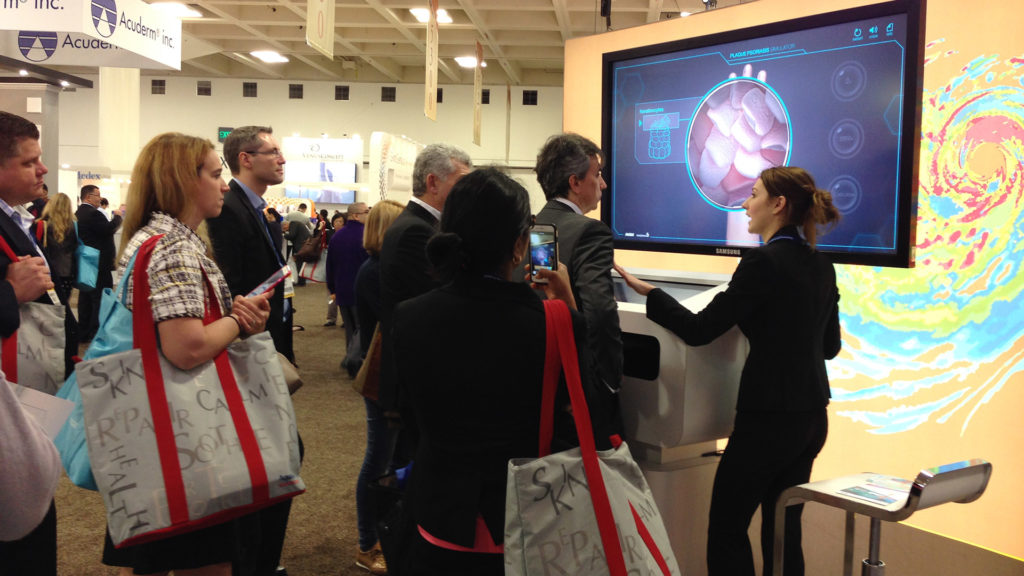
The right team
Delivering extraordinary interactive conference experiences requires an exceptional team: multidisciplinary, highly creative, and science-literate. At AXS Studio, our in-house medical communication designers, animators and developers work hand-in-hand, combining user experience (UX) design, science visualization, and interactive programing to bring unique, inspiring ideas to life. With graduate training, certification, and deep experience in scientific communications, we ensure your content is presented accurately from concept to completion.
Design for results
Other agencies start with a technology—eg. VR or AR—and design a medical or scientific conference activity to fit. We believe it’s best to start with your learning objectives then design using the best tech to meet those objectives and deliver the results you’re after. For us, a great user experience goes beyond new and flashy tech. It’s about booth visitors feeling engaged with your medical content. We use interactive technology—be it gesture tracking, mixed reality or a hologram—to facilitate an unforgettable connection with your message.
Prepared for success
Getting interactive conference activities through MLR or PRC reviews presents unique challenges. A multiplayer oncology game, for example, is beyond the experience of most reviewers. The content and user actions must be presented in a format that is easily understood and efficient to review. For non-linear experiences, in which users choose their own paths through content, all possible user journeys must be clearly mapped out for reviewers. At AXS Studio, we’ve shepherded dozens of “out-of-the-box” interactive conference activities successfully through rigorous review processes.
Unexpected ideas
Interactivity connects people with learning experiences in ways not possible with traditional media. This unlocks creative possibilities for medical and scientific communications. For instance, we can demonstrate pathophysiology on a live scan of the learner, or have them search for sites of disease. Dynamic content can be explored by multiple users at their own pace. And customers can simulate using a new medical device instead of watching or reading about it. We use a design thinking approach to tap into our collective creativity to reveal unexpected ideas for your next conference exhibit.
Frequently Asked Questions
If you’d like to learn more about our services, simply contact us with information about your project, including learning objectives and timelines. We’ll schedule a consultation call to discuss your needs and provide you with a custom proposal and estimate for review.
Most healthcare or medcomm agencies outsource their interactive design and development to generalists. AXS Studio is unique in this space for employing scientifically trained designers and digital artists. Our medical communication designers, certified medical illustrators and medical animators have scientific backgrounds. And each holds an M.Sc. degree in biomedical communications from one of the five graduate programs accredited by CAAHEP. We are trained in cell biology, anatomy, physiology, pathology and molecular visualization. We have over 20 years experience visualizing complex medical science for discerning HCP audiences. Five board-Certified Medical Illustrators (CMIs) on our team ensure scientific accuracy on every interactive conference activity we design. We speak your language and communicate complex scientific concepts more accurately and clearly than generalists.
The complexity and functional requirements of an activity are the biggest determinants of its cost. We’ll take your budget into account when proposing a solution. Our fees include:
- Experience design
- Visual asset creation
- 3D/2D animation
- Programming (game or web development)
- Custom hardware/electronics
- Testing, deployment and support
All content creation, design and development is done in house at our Toronto studio. There are no cost markups passed on to our clients. If you would like an estimate for your interactive app or experience, please reach out.
We’re a full-service studio, with in-house capabilities covering the full development pipeline. Our quotes include ideation, UX design, content research and script writing, wireframing, 3D modeling and animation, user interface (UI) design, audio production, programming, testing, support and training. Along the way, we prepare materials for MLR or PRC review and can handle submission via Veeva or other CMS, if desired.
We take our content research seriously. Our scientifically trained designers and digital artists immerse themselves in the literature for your content. Before drawing a single wireframe panel, we compile a meticulous visual research deck to support the creation of all visual assets. We’re committed to ensuring your science is communicated accurately.
Clients frequently express relief after switching to AXS Studio. They cite challenges faced with their previous agencies:
- Previous vendor struggled to understand the purpose of the project
- Stressful, last-minute deliveries
- Surprise onsite technical problems at their exhibit booth
- Lack of support when something goes wrong
- Unexpected charges from the agency to fix their own errors
In contrast, clients have described AXS Studio as “a talented and reliable partner”. They’ve cited “the incredible quality and attention to detail in [our] work,” and “the commitment [we] have to pulling off the impossible.” Clients express relief at no longer worrying about making deadlines or being surprised with unplanned overages after a project delivers. And AXS Studio collaborates exceptionally well with booth and AV suppliers, who say we’re “always thinking ahead and thinking proactively.”
When it comes to results, biopharma and medical-device companies know they can rely on AXS Studio to deliver unique, creative interactive media solutions “that boost traffic and HCP engagement at … congress booths.” But don’t take our word for it, see what our clients have to say.
It’s important to start early, especially if your company has an involved material review and approval process. While timelines depend on the scope and content of the activity, they typically range from four to six months. We recommend contacting us at least 6 months ahead of your deadline to be safe. We’ll include a detailed timeline with key milestones in your project proposal.
We recommend targeting 5 minutes or less. HCPs are busy people, with limited time to absorb your content. It can be tempting to cram as much content as possible into an interactive experience. However, what matters most is making a positive and memorable impression, while imparting the essential messages. We recommend focusing on no more than three key information takeaways and an enjoyable experience.
- First, define your learning objectives and primary audience. The audience will inform the language and complexity of your interactive activity.
- Provide us with key resources, including journal review papers, scientific posters and scientific presentation or training decks.
- The AXS Studio team will conduct ideation sessions and present you with a proposed solution, complete with concept art.
- Once you green light the concept for the interactivity, we’ll prepare a content outline for your review. Next comes a script with proposed voiceover and/or onscreen text, or “supers”. Scripts typically go through two rounds of review.
- Next, we’ll create a wireframe to map out the activity and give your team a clear picture of the content and user experience. There are typically two rounds of wireframe review, followed by an MLR review.
- Following wireframe approval, we develop an alpha version of the interactive activity. Alpha is for review and approval of the user experience and draft visuals. It is usually accompanied by sample still renderings that show the proposed final look. The alpha application goes through user testing to identify and implement areas for improvement.
- Beta development incorporates any revisions from alpha. At this stage we conduct system testing with your booth and/or AV vendors. The beta version presents the final look, includes final audio, and is submitted for MLR review and approval.
- Following MLR approval, we deploy the final application to your exhibit booth in collaboration with your other vendors.
Medical and scientific communications managers commission these activities to educate HCPs at medical affairs congress booths. The subject matter is usually disease state and/or mechanism of action. Interactive conference activities are sometimes repurposed on medical affairs websites, providing ongoing value to providers.
Product managers and marketing managers commission interactive activities to showcase new medical devices at their conference booths.
Educational institutions such as museums and science centers use interactive activities, including scientific games to engage the public and get visitors excited about science learning.
We recommend assigning a facilitator to engage visitors and introduce them to the activity. While we design interactive apps and experiences to be used without support by making them simple to use and providing on-screen and audio instructions, a human touch always results in higher participation and better user experiences. Many companies use trained facilitators for this purpose. We can recommend a vendor we’ve had great experience with.
AXS Studio usually does the preliminary design. We then coordinate with our clients’ booth suppliers who build the structures to our specifications. Sometimes we design and fabricate custom kiosks and electronics in house when their function is central to the interactive experience. And we work with our clients’ AV vendors to spec the hardware and pretest the interactivity well in advance. We ensure everything is tested and production-ready, ensuring a smooth and successful launch for your booth activity.


